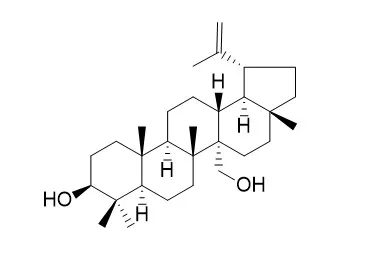| Structure Identification: |
| Chin J Nat Med . 2015 Apr;13(4):307-310. | | Antibacterial constituents from Melodinus suaveolens[Pubmed: 25908630] | | To investigate the non-alkaloidal chemical constituents of the stems and leaves of Melodinus suaveolens and their antibacterial activities. Compounds were isolated and purified by repeated silica gel, Sephadex LH-20, RP18, and preparative HPLC. Their structures were elucidated by comparison with published spectroscopic data, as well as on the basis of extensive spectroscopic analysis. The antibacterial screening assays were performed by the dilution method. Fourteen compounds were isolated, and identified as lycopersene (1), betulinic aldehyde (2), 3β-acetoxy-22,23,24,25,26,27-hexanordammaran-20-one (3), 3a-acetyl-2, 3, 5-trimethyl-7a-hydroxy-5-(4,8,12-trimethyl-tridecanyl)-1,3a,5,6,7,7a-hexahydro-4-oxainden-1-one (4), 3β-hydroxy-28-norlup-20(29)-ene-17β-hydroperoxide (5), 3β-hydroxy-28-norlup-20(29)-ene-17α-hydroperoxide (6), β-sitosterol (7), 28-nor-urs-12-ene-3β, 17β-diol (8), α-amyrin (9), ergosta-4,6,8(14),22-tetraen-3-one (10), 3β-hydroxy-urs-11-en-28,13β-olide (11), betulin (12), Obtusalin (13), and ursolic acid (14). Among the isolates, compounds 1, 2, 6, 8, 10, and 14 showed potent antibacterial activities against the four bacteria. This is the first report of the antibacterial activity of the constituents of Melodinus suaveolens. | | Zhongguo Zhong Yao Za Zhi . 2020 Aug;45(15):3689-3693. | | [A new macrocyclic phenolic glycoside from Sorghum vulgare root][Pubmed: 32893559] | | Eleven compounds were isolated and purified from Sorghum vulgare root extract, through column chromatography over silica gel, MCI gel, and preparative HPLC. Their structures were established by MS, 1 D NMR and 2 D NMR data as sorgholide A(1), β-sitosterol(2), stigmastero(3), daucosterol(4), 4-methoxycinnamic acid(5), taxiphyllin(6), chlorogenic acid(7), p-hydroxybenzaldehyde(8), succini acid(9), trans-p-hydroxycinnamic acid(10), Obtusalin(11). Compounds 4,5 and 9-11 were reported from this species for the first time, and compound 1 is the first 24 ring dimeric double lactonol glycoside formed by reverse polymerization of p-hydroxyphenylacetate glucoside, named sorgholide A. | | Nat Prod Res . 2020 Dec;34(23):3313-3319. | | A new pentacyclic triterpenoid from the leaves of Rhododendron dauricum L. with inhibition of NO production in LPS-induced RAW 264.7 cells[Pubmed: 30810367] | | A new pentacyclic triterpenoid, 3-oxo-urs-11,13(18)-dien-28-oic acid (1), along with twelve known triterpenoids, α-amyrin (2), 19α-hydroxy-α-amyrin (3), triptohypol E (4), uvaol (5), 2α,3α-dihydroxyurs-11-en-13β,28-olide (6), 3β-hydroxyurs-11-en-13β,28-olide (7), ursolic acid (8), asiatic acid (9), oleanolic acid (10), aegiceradienol (11), Obtusalin (12) and betulinic acid (13) were isolated from the leaves of Rhododendron dauricum L. Their structures were established from spectroscopic data and comparison with reported values. Among them, compounds 3, 4, 6, 7 and 11 were isolated from the Ericaceae family for the first time. Compounds 2, 5, 9, 12 and 13 were obtained from R. dauricum for the first time. Additionally, compounds 6, 10 and 11 significantly inhibited the levels of NO in LPS-stimulated RAW 264.7 cells at 3 μM. | | Zhongguo Zhong Yao Za Zhi . 2010 Feb;35(3):315-322. | | [Terpenoids of Heteroplexis micocephala and their bioactivities][Pubmed: 20422996] | | Objective: To investigate the chemical constituents of Heteroplexis nicocephala.
Method: The constituents were isolated by using a combination of various chromatographic techniques including column chromatography over silica gel, Pharmadex LH-20, and C-18, as well as reversed-phase HPLC. Structures of the isolates were identified by spectroscopic data analysis. In vitro cytotoxic, neuroprotective, and anti-inflammatory activities were screened by using cell-based models.
Result: Seventeen terpenoids were isolated. The structures were identified as two monoterpenoids: (-)-bomyl ferulate(1) and loliolide(2). Seven sesquiterpenoids: 1beta-hydroxy-alpha-cyperone(3) , alpha-rotunol(4), 10alpha-hydroxycadin-4-en-15-al (5), 1-epi-10beta-hydroxycadin-4-en-15-al(6), 10alpha-hydroxyisodauc-3-en-15-al(7), germacrene B(8), and mandassidione(9). Five diterpenoids: 12-epi-bacchotricuneatin A(10), 1-hydroxy-12-epi-bacchotricuneatin A(11), cleroinermin(12), desoxyarticulin(13), and anhydroolearin(14). And three triterpenoids: friedelin (15), ursolic acid(16), and Obtusalin(17). In the in vitro assays, 1 showed selective cytotoxic activity against BGC-823, with an IC50 value of 8.00 x 10(-5) mol x L(-1). At a concentration of 1 x 10(-5) mol x L(-1), 12 showed neuroprotective activity against MPP+ induced PC12-syn cell damage, with a relative cell proliferation rate of 104.32% (P < 0.001). 2 exhibited inhibitory activity against the release of beta-glucuronidase from the polymorphous nuclear leukocytes induced by PAF, with an inhibitory rate of 52.7% (P < 0.05) at the same concentration.
Conclusion: Compounds 1-17 were obtained from the genus Heteroplexis for the first time. 1 showed selective cytotoxic activity against human gastric cancer cell lines (BGC-823), 12 and 2 showed potent neuroprotective and anti-inflammatory activities, respectively. |
|






 Cell. 2018 Jan 11;172(1-2):249-261.e12. doi: 10.1016/j.cell.2017.12.019.IF=36.216(2019)
Cell. 2018 Jan 11;172(1-2):249-261.e12. doi: 10.1016/j.cell.2017.12.019.IF=36.216(2019) Cell Metab. 2020 Mar 3;31(3):534-548.e5. doi: 10.1016/j.cmet.2020.01.002.IF=22.415(2019)
Cell Metab. 2020 Mar 3;31(3):534-548.e5. doi: 10.1016/j.cmet.2020.01.002.IF=22.415(2019) Mol Cell. 2017 Nov 16;68(4):673-685.e6. doi: 10.1016/j.molcel.2017.10.022.IF=14.548(2019)
Mol Cell. 2017 Nov 16;68(4):673-685.e6. doi: 10.1016/j.molcel.2017.10.022.IF=14.548(2019)